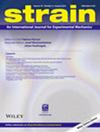Investigation of the 2D assumption in the image‐based inertial impact test
IF 1.8
3区 材料科学
Q2 MATERIALS SCIENCE, CHARACTERIZATION & TESTING
引用次数: 1
Abstract
The image‐based inertial impact (IBII) test has shown promise for measuring properties of composites at strain rates where existing test methods become unreliable due to inertial effects (> 102 s−1). Typically, the IBII tests are performed with a single camera, and therefore, to use surface measurements for material property identification, it is necessary to assume that the test is two‐dimensional. In this work, synchronised ultra‐high‐speed cameras are used to quantify the relevance of this assumption when nonuniform, through‐the‐thickness loading is applied to interlaminar samples. Initial experiments revealed that an angular misalignment of approximately 1° between the impact faces of the waveguide and projectile created a bending wave that propagated along the sample behind the axial pulse. Even under these conditions, consistent measurements of stiffness were made by assuming a linear distribution of the behaviour through‐the‐thickness. When the misalignment was reduced to 0.2°, the effects on single‐sided measurements were significantly reduced. The two alignment cases were compared to show that three‐dimensional loading had a small effect on stiffness identification (approximately 5% bias) relative to failure stress (approximately 30% bias). This study highlights the importance of impact alignment for reliable characterisation of the interlaminar failure stress and was used to establish guidelines for diagnosing loading issues from single‐sided measurements.基于图像的惯性冲击试验中二维假设的研究
基于图像的惯性冲击(IBII)测试显示出在应变速率下测量复合材料性能的前景,现有的测试方法由于惯性效应(bbb102s−1)而变得不可靠。通常,IBII测试是用单个相机进行的,因此,为了使用表面测量来识别材料性能,有必要假设测试是二维的。在这项工作中,同步超高速相机被用来量化当非均匀的厚度加载应用于层间样品时这一假设的相关性。最初的实验表明,波导和弹丸的冲击面之间的角度偏差约为1°,产生了弯曲波,沿着轴向脉冲后面的样品传播。即使在这些条件下,通过假设通过厚度的线性分布,也可以得到一致的刚度测量结果。当误差减小到0.2°时,对单面测量的影响显著减小。对比了两种对中情况,发现三维载荷对刚度识别的影响较小(约5%的偏差),相对于破坏应力(约30%的偏差)。该研究强调了冲击对准对层间破坏应力可靠表征的重要性,并用于建立单侧测量诊断加载问题的指南。
本文章由计算机程序翻译,如有差异,请以英文原文为准。
求助全文
约1分钟内获得全文
求助全文
来源期刊

Strain
工程技术-材料科学:表征与测试
CiteScore
4.10
自引率
4.80%
发文量
27
期刊介绍:
Strain is an international journal that contains contributions from leading-edge research on the measurement of the mechanical behaviour of structures and systems. Strain only accepts contributions with sufficient novelty in the design, implementation, and/or validation of experimental methodologies to characterize materials, structures, and systems; i.e. contributions that are limited to the application of established methodologies are outside of the scope of the journal. The journal includes papers from all engineering disciplines that deal with material behaviour and degradation under load, structural design and measurement techniques. Although the thrust of the journal is experimental, numerical simulations and validation are included in the coverage.
Strain welcomes papers that deal with novel work in the following areas:
experimental techniques
non-destructive evaluation techniques
numerical analysis, simulation and validation
residual stress measurement techniques
design of composite structures and components
impact behaviour of materials and structures
signal and image processing
transducer and sensor design
structural health monitoring
biomechanics
extreme environment
micro- and nano-scale testing method.
 求助内容:
求助内容: 应助结果提醒方式:
应助结果提醒方式:


